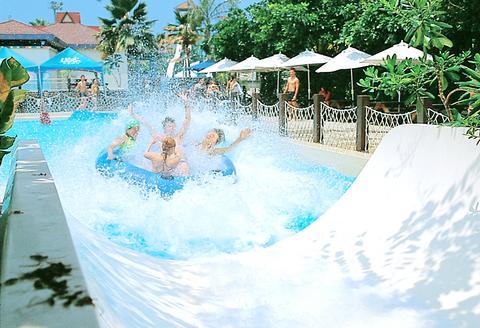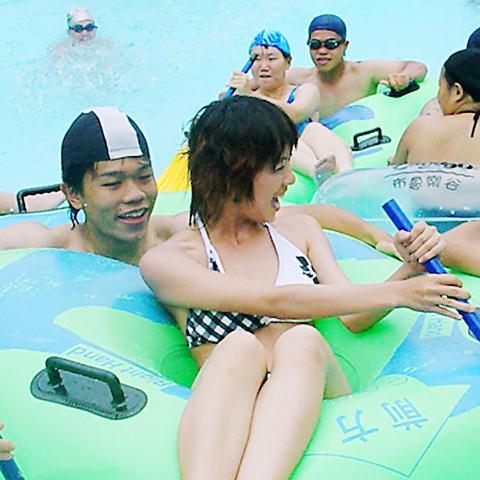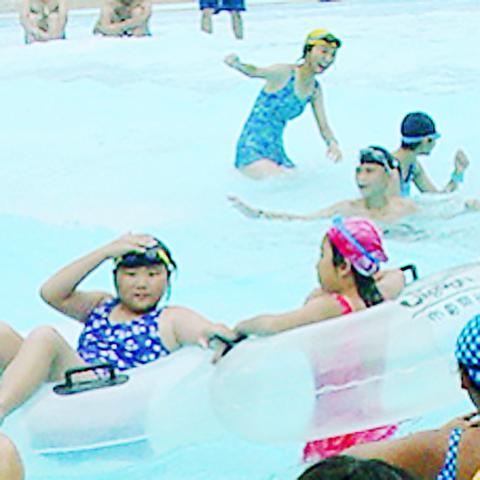Few adults get excited about whizzing down a slide at a playground, but add water to the equation and suddenly people are pushing past the kids to queue up. Something about water slide parks makes them enjoyable for people of all ages -- and a recent trip to Formosa Fun Coast, in Bali near Danshui, confirmed this. A look around the park at closing time noted that a majority of the people left were well over 30.
The first of its kind in Taiwan, Formosa was constructed in Taipei County in 1989. Ten years later, Taichung and eventually Kaohsiung slid into action and opened international-class water parks of their own.

PHOTO COURTESY OF FORMOSA WONDER WORLD
It was raining in Taipei but after a 30-minute drive out of the cloudy valley into Bali it was perfect sliding weather. Even on a Tuesday afternoon there were enough people out to cause a bit of wait at the more popular slides.

PHOTO COURTESY OF FORMOSA WONDER WORLD
The longest queue, still less than 10 minutes, was at the rafting tube slides, with people splashing into one another like bumper cars on the way down. Next to the tube slides is the Jet Stream, which requires visitors to pass a swim test before going down the short slide that drops 20m into a deep pool of water.
The fastest slide and the one you "get the most air on," according to two young, waterslide veterans, is in the "Bermuda Triangle" area. It is a 300m slide with a freefalling drop, and on first go it's the thought of falling out that makes it exciting. After a few times, however, the fear subsides and mastering the skill of gaining speed, or air, becomes an obsession.

PHOTO COURTESY OF FORMOSA WONDER WORLD
For a break from the slides, or for more family entertainment, there is a relaxing 20-minute tube ride, a water play area and a shallow pool area with water guns and other equipment suitable for young children.

PHOTO COURTESY OF FORMOSA WONDER WORLD
The Caribbean-themed park has suffered some natural wear and tear over the past 15 years but apart from the dressing rooms, which could do with a refit, the rest of the park's 3.64 hectares is in great shape. Divided into different areas, the facility accommodates every need, from food, drinks, souvenirs, and first aid, in case someone did fall out of a slide, which to date hasn't happened. There are plenty of Western and Chinese style fast food outlets offering everything from hotdogs and French fries to chou doufu (臭豆腐) and barbecue. There is also a fair selection of ice cream and beverage stands.
Formosa sees approximately 500,000 visitors a year, most of whom turn out on the weekend. To avoid long queues, weekday or evening excursions are best. Evening sliding also provides for a good view of the coast and Bali skyline.
"It might be the oldest, but Formosa does its best to keep visitors coming back for more," said Chen Yu-cheng (陳玉城) a public relations officer with the park.
During its 15-year history, the park has added 10 new slides and six new facilities.
It took a few years but when Taichung got around to constructing its own water park they did so with vehemence. Part of the Yamay Resort, Mala Bay planners went all out contracting several foreign and Taiwan companies to build "the number one water park in Taiwan," according to Tsai Mei-ling (
There are plenty of long, winding, fast slides, but the biggest attraction is Big Wave, which is Asia's largest wave pool with waves up to 2.4m in height, Tsai said. One advantage to a day spent at Mala Bay is E-band, a waterproof electronic device that allows people to put money into an account that can be debited throughout the day, thus eliminating the hassle of carrying around cash. It'ssomething every water park would benefit from.
Similar to the other two, Kaohsiung's Blue Lagoon offers plenty of restaurants, rest areas and more importantly first-rate slides. The park's highlights include Thunder River, with slides for single or double rafting tubes and Terror Tower, an 18m tower slide with a high-speed free falling drop, according to Nova Tseng (曾憲立), a Blue Lagoon representative.
Formosa will close for the season at the end of September, but both Mala Bay and Blue Lagoon will stay open until mid-October. The summer heat sends many to the beach, but for a change of pace, a day spent at one of Taiwan's three first class water parks can provide hours of entertainment, with no swim caps required.
About the water parks:
Formosa Wonder World (八仙水上樂園)
Where: 1-6, Xia She Zi, Xia She Tsun, Pali Township, Taipei County (台北縣八里鄉下罟村一鄰下罟子1-6號)
Telephone: (02) 2610 5200
Summer Hours: 9am to 9:30pm
Cost: NT$590
How to get there: From Guandu MRT take bus number R13 or R22
Mala Bay (馬拉灣)
Where: 115, An Mei Road, Houli Township, Taichung County (台中后里鄉安眉路115號)
Telephone: (04) 2558 3488
Summer Hours: 9am to 9pm
Cost: NT$450
How to get there: From Taichung train station take Fengyuan city company bus.
Blue Lagoon Water park (布魯樂谷主題親水樂園)
Where: 700, Kai Shuan 4th Road, Kaohsiung (高雄市前鎮區凱旋四路700號)
Telephone: (07) 811 9780
Summer Hours: 8am to 11:30pm
Cost: NT$ 500
How to get there: From Kaohsiung train station take bus number 37.

Following the rollercoaster ride of 2025, next year is already shaping up to be dramatic. The ongoing constitutional crises and the nine-in-one local elections are already dominating the landscape. The constitutional crises are the ones to lose sleep over. Though much business is still being conducted, crucial items such as next year’s budget, civil servant pensions and the proposed eight-year NT$1.25 trillion (approx US$40 billion) special defense budget are still being contested. There are, however, two glimmers of hope. One is that the legally contested move by five of the eight grand justices on the Constitutional Court’s ad hoc move

Stepping off the busy through-road at Yongan Market Station, lights flashing, horns honking, I turn down a small side street and into the warm embrace of my favorite hole-in-the-wall gem, the Hoi An Banh Mi shop (越南會安麵包), red flags and yellow lanterns waving outside. “Little sister, we were wondering where you’ve been, we haven’t seen you in ages!” the owners call out with a smile. It’s been seven days. The restaurant is run by Huang Jin-chuan (黃錦泉), who is married to a local, and her little sister Eva, who helps out on weekends, having also moved to New Taipei

The Directorate-General of Budget, Accounting and Statistics (DGBAS) told legislators last week that because the Chinese Nationalist Party (KMT) and Taiwan People’s Party (TPP) are continuing to block next year’s budget from passing, the nation could lose 1.5 percent of its GDP growth next year. According to the DGBAS report, officials presented to the legislature, the 2026 budget proposal includes NT$299.2 billion in funding for new projects and funding increases for various government functions. This funding only becomes available when the legislature approves it. The DGBAS estimates that every NT$10 billion in government money not spent shaves 0.05 percent off

Dec. 29 to Jan. 4 Like the Taoist Baode Temple (保德宮) featured in last week’s column, there’s little at first glance to suggest that Taipei’s Independence Presbyterian Church in Xinbeitou (自立長老會新北投教會) has Indigenous roots. One hint is a small sign on the facade reading “Ketagalan Presbyterian Mission Association” — Ketagalan being an collective term for the Pingpu (plains Indigenous) groups who once inhabited much of northern Taiwan. Inside, a display on the back wall introduces the congregation’s founder Pan Shui-tu (潘水土), a member of the Pingpu settlement of Kipatauw, and provides information about the Ketagalan and their early involvement with Christianity. Most